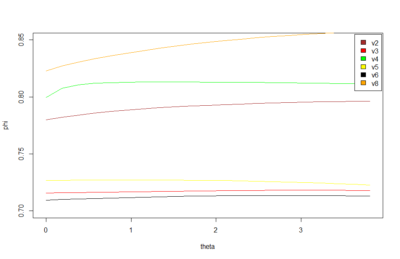SMAP results
on Monday, October 9th, 2017 2:34 | by Christian Rohrsen
These are the results of the SMAP for the TNTxWTB. I also have done a few for the c105;;c232xWTB but there is not much to say. I would say that the cleanest lines show a bigger slope, but prone to subjectiveness.
In addition, I have done some animations of the attractors that I have posted on slack because of size.
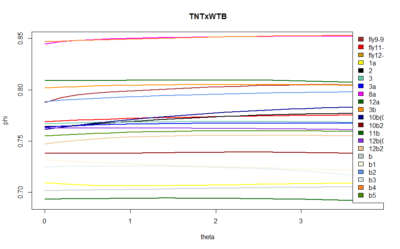
Category: flight, genetics, R code, Spontaneous Behavior, strokelitude, WingStroke | No Comments
Attractors for c105;;c232>TNT
on Monday, October 2nd, 2017 5:35 | by Christian Rohrsen
This is what I showed about one fly from this line showing the attractor.
This graph is what I forgot to show in the lab meeting. There are the 6 best traces from this same line. All of them selected ad hoc subjectively. The three best of them to my eyes are exactly the three above in the graph (v8-this one is the one shown in the picture with the attractors-,v4,v2). What does this means? the ones with better traces (subjectively) have higher offset in the phi, this means that they are more predictable overall (maybe because more resolution?). In addition, they show higher slopes which means more nonlinearity.
Category: flight, Spontaneous Behavior, strokelitude, WingStroke | No Comments
Measuring Wingstroke Amplitude with Strokelitude (V)
on Monday, December 14th, 2015 2:42 | by Pablo Martinez
For a further data analysis, we should have a minimum number of samples. During the last week, I have been measuring the wingstroke amplitude of the flies, to get at least 10 samples of each one(two controls and the experimental line). Here three examples of the different lines:
Males WTB x C105;;C232 (control)
Males UAS-TNT-E x C105;;C232
Males UAS-TNT-E x WTB (control)
Category: flight, Spontaneous Behavior, strokelitude, WingStroke | No Comments
Measuring Wingstroke Amplitude with Strokelitude (IV)
on Monday, December 7th, 2015 2:56 | by Pablo Martinez
After getting good results in the measurement of the wingstroke, and solving problems with the sampling intervals (image below). I have started to measure flies for the experiments.
The time between samples was different depending on the background programs running on the background:
Figure 1
More differences in time within samples when more programs are running at the same time as strokelitude (3nd 1/3 of the plot), when just the display of the camera is running( 1st 1/3 of the plot), and everything shut down(2nd 1/3 of the plot).
The differences among sampling intervals was bigger but with an adjustment of the data, Christian Rohrsen managed to changed. The time between two samples could arise until 1.7 seconds and with the correlation, the time is not bigger than 0.05 seconds.
The strains of flies used fore the experiments are:
UAS-TNT-E, that express the tetanus toxin in the neural cells, using GAL4 system. Being Used as a control.
c105;;c232, that contains a promotor region to express the toxin. Being used as a control.
And the cross between both to have the expression of the tetanus toxin.
Some data from the control flies (UAS-TNT-E):
And some data of the spikes:
Category: flight, Spontaneous Behavior, strokelitude, WingStroke | No Comments
Interpolations and Spike analysis
on Monday, December 7th, 2015 2:42 | by Christian Rohrsen
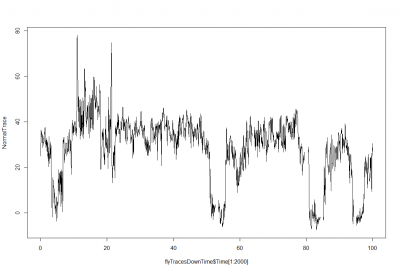
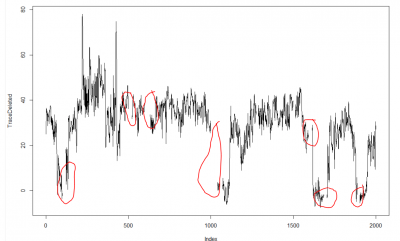
 This is just a proof of concept how useful the interpolation is for this purpose: and I would say it´s almost useless. If I delete from the raw data (1st graph) some pieces (2nd graph), and I make a spline interpolation (3rd graph) it doesn´t match that well. Linear interpolation was done in previous weeks with not much of a success. Anyway, the result of a linear interpolation can be imagined by eye just by joinning the two ends with a straight line, and this doesn´t occur in the fly behavior as we can see in the raw data (1st graph).
This is just a proof of concept how useful the interpolation is for this purpose: and I would say it´s almost useless. If I delete from the raw data (1st graph) some pieces (2nd graph), and I make a spline interpolation (3rd graph) it doesn´t match that well. Linear interpolation was done in previous weeks with not much of a success. Anyway, the result of a linear interpolation can be imagined by eye just by joinning the two ends with a straight line, and this doesn´t occur in the fly behavior as we can see in the raw data (1st graph).
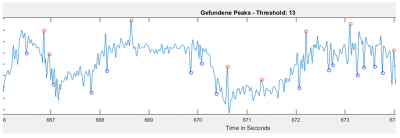
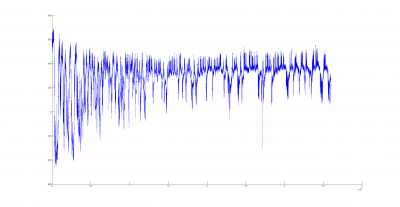
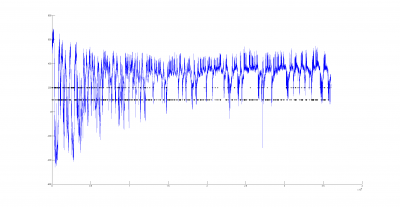
 There could be two posibilities for spike detection: one is the one from Ute and the other one is the one from Maye. It seems to me that the one from Maye is more precise. I have run the script but I do not get so many spike detections as he gets. I did try several thresholds for spike detection and doesn´t change very much. So I have to work more on it to see what is really the important factor for a proper spike detection
There could be two posibilities for spike detection: one is the one from Ute and the other one is the one from Maye. It seems to me that the one from Maye is more precise. I have run the script but I do not get so many spike detections as he gets. I did try several thresholds for spike detection and doesn´t change very much. So I have to work more on it to see what is really the important factor for a proper spike detection
Category: flight, R code, Spontaneous Behavior, strokelitude, WingStroke | No Comments
Tdc2 and Bruchpilot in flight
on Tuesday, March 26th, 2013 7:00 | by Christine Damrau
Tested the third cross. Now, it is around 15n each group. After a control experiment I preferred a recovery time of 1h instead of 5h. A short pilot for control groups showed that Tdc2virgins crossed to w1118males have a flight defect.
3rd
Category: Biogenic Amines, flight | 4 Comments
publishing torque meters comparison
on Wednesday, March 6th, 2013 11:17 | by Julien Colomb
here is the draft: https://figshare.com/preview/_preview/644625
Is there any good publication describing the wing beat analyser?
other remarks?
Category: flight, open science, Spontaneous Behavior, writing/publishing | No Comments
First flight tests, Trehalose again…
on Thursday, November 1st, 2012 7:33 | by Christine Damrau
Chrisi’s day…
1 Collected virgins for our ill post-doc, made some crosses:
d42-GAL4 males x tubGAL80-UAS-PKCi and x CS
d42-chaGAL80 males x tubGAL80-UAS-PKCi and x CS
2 Buridan: Prepared colored food (10mg/ml, 2.5ml total in the very little vials, ~ 5 flies in each vial). Denise tested in the afternoon females in the Buridan. Data (4n now) will be shown in the lab meeting.
3 Imaging Made a new cross for the Imaging-project:
TDC2-GAL4 males x UAS-GCaMP3(2)
replaced Neloy’s flies by flies from stock
Florian’s larval preparation (good!) showed that GCaMP-expression is much less than GFP-expression. They hope for the homozygous line.
4 Flight: Performed flight experiments with the tbh,TDC,UAStbh flies. Raw data, see below. Thinking about analysis (probably tomorrow)
Protocol: glued the day before, sugar in wheel chambers, little EVIAN-water.
5s filter on the legs before starting, aspirated, stopped when no response 3 times in a row, stopped time when 30min, stopped after 15 aspiration trials
| date | fly | genotype | number_aspiration | time_to_first_stop | duration_of_flights | remarks |
| 01.11.2012 | 1 | 12 | 4.56 | 4.56,0.22,0.30,0.2 | ||
| 01.11.2012 | 2 | 2 | 49.15 | 49.15,14.42 | ||
| 01.11.2012 | 3 | 16 | 0.03 | 0.03,0.15,3.06,1.56,0.3,0.14,4.58,0.22 | ||
| 01.11.2012 | 4 | 3 | 0 | 0 | ||
| 01.11.2012 | 5 | 40 | 0.05 | 0.05,0.01,0.02,0.01,0.01,0.02,0.02,0.01,0.02,0.03,0.02,0.02,0.01,0.01,0.01,0.01,0.01,0.04,0.09,0.01,0.02,0.01,0.11,0.01,0.01,0.01,0.01,0.01,0.02,0.01,0.03 | ||
| 01.11.2012 | 6 | 3 | 0 | |||
| 01.11.2012 | 7 | 13 | 3.01 | 0.01,0.01,0.01,0.01,0.01,0.02,0.01 | ||
| 01.11.2012 | 8 | 15 | 0.01 | 0.01,0.04,0.03,0.02,1.56,0.15,0.02,1.46,3.26,1.15,0.46,6.45,2.56,0.06,12.59 | ||
| 01.11.2012 | 9 | 15 | 0.01 | 0.01,0.01,0.28,0.1,1.5,1.29,0.40,0.29,1.34,0.54,0.22,0.37,0.31,0.54 | ||
| 01.11.2012 | 10 | 9 | 0.01 | 0.01,0.01,0.01,0.01,0.01 | ||
| 01.11.2012 | 11 | 12 | 0.01 | 0.01,0.01,0.01,0.01,0.01,0.01 | ||
| 01.11.2012 | 12 | 3 | 0 | |||
| 01.11.2012 | 13 | 4 | 0.06 | 0.06,0.5,0.06,38.2 | ||
| 01.11.2012 | 14 | 3 | 0.19 | 0.19,0.33,0.31,30 | ||
| 01.11.2012 | 15 | 15 | 3.38 | 3.38,2.43,0.47,0.36,4.06,0.39,1.25,0.35,0.52,1.07,0.22,0.23,0.27 | ||
| 01.11.2012 | 16 | 3 | 0 | |||
| 01.11.2012 | 17 | 3 | 7.16 | 7.16,23.27,30 | ||
| 01.11.2012 | 18 | 3 | 0 | |||
| 01.11.2012 | 19 | 6 | 1.33 | 1.33,14.57,9.17,30 | ||
| 01.11.2012 | 20 | 1 | 18.20 | stopped the expriment | ||
| 01.11.2012 | 21 | 3 | 2.50 | 2.50,2.18 | stopped the expriment |
5 Trehalose: Found time to try out Gérard’s idea (no pigment in the probes to not disturb the NanoDrop measurement). 4 groups: 10 flies with or without heads, 50 flies with or without heads. Hilde showed me how to remove heads with liquid nitrogen and vortex. The other flies (with heads) were frozen at -20° as usual. Trehalase incubation over night. Tomorrow glucose oxidase and measurement
Category: Biogenic Amines, buridan, flight, trehalose measurement | No Comments


